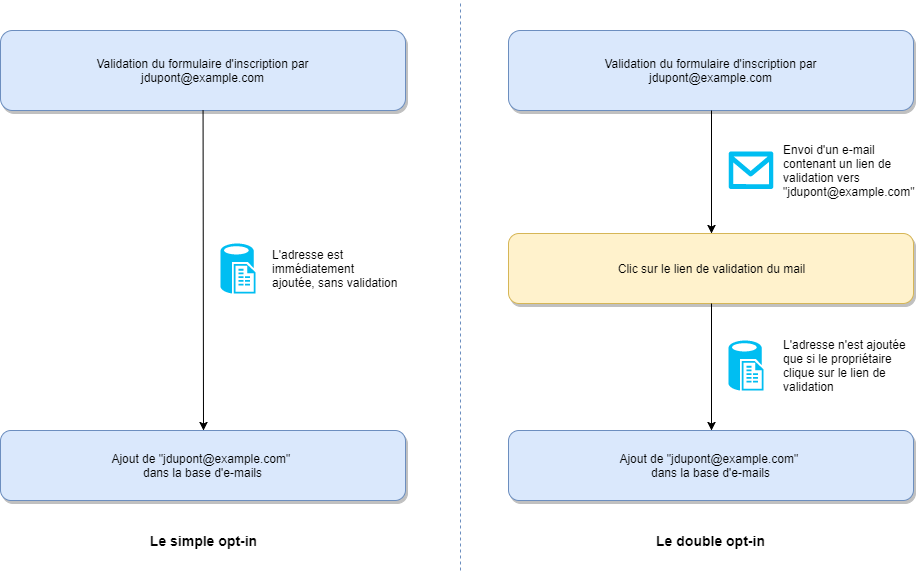What is double opt-in?
Updated on April 21, 2025
Although not required by law, the principle of double opt-in is highly recommended for building healthy databases.
In the context of B2C communications, opt-in - in other words, the prior consent of the internet user - must be collected as a mandatory requirement. This is most often done through a checkbox in an online registration form. The checkbox must not be pre-checked for the commitment to be explicit. It can be titled, for example, “I wish to receive Tartempion’s newsletter” or “I agree to receive commercial offers from Bidule.”
Simple opt-in, while legally sufficient, has several technical shortcomings that are addressed by double opt-in.
The principle of double opt-in
The double opt-in process involves informing the registered person, after filling out the opt-in form, that they will receive an email inviting them to confirm their registration. The email address of the registrant will only be kept in the database if the owner clicks on the confirmation link.
A simple diagram to summarize and understand the difference between the two methods:

Advantages of double opt-in
Double opt-in helps to mitigate the following risks:
- Risk of typing errors
When filling out the newsletter subscription form, the internet user may make a typing error.
In the best-case scenario, the incorrect address will result in a “Returned to Sender” message for the reason “Address Not Found.”
Worse, your message may end up with someone who did not request it, potentially marking it as spam, damaging both your sender reputation and the server’s reputation that sent the email.
Even worse, with a stroke of bad luck, you may end up with an address that exists but corresponds to a spam trap, which will seriously harm your deliverability in the long run. In any case, it’s best to quickly get rid of incorrect addresses, which double opt-in allows you to do flawlessly.
- Risk of transcription errors
An address can also be collected through opt-in via a paper form, such as at a store checkout when the owner fills out a loyalty card application form and checks the box “I agree to receive promotions by email.” The person transcribing the address into the database is not immune to making a typing error. Additionally, some handwriting may not always be easy to decipher, increasing the risk of errors. Sending a confirmation email before inserting the address into the database is a wise precaution in this case as well.
- Risk of someone providing someone else’s address
This could be the work of Robert Bidochon, who secretly signs up his friend Marcel for the “Lovers of Andouillette” newsletter because he knows Marcel detests it. (What a joker, that Robert!). As a result, there is a good chance that the “Lovers of Andouillette” will see their reputation decline due to Marcel’s spam complaint. However, more seriously, this could also come from a competitor intentionally trying to “poison” your database (list poisoning). Whether a joke or an attempt to harm, if the person unknowingly signed up receives a confirmation email before your first newsletter, they will not click on the confirmation link, thereby preserving your reputation.
Disadvantages of double opt-in
To be honest, there are none.
Some may argue that it adds an extra step in the registration process, leading to potential losses. It’s true that some hesitant individuals may not complete their registration, as they have time to think and back out. Ultimately, it’s a case of short-term pain for long-term gain: from a reputation/deliverability standpoint, it’s better to use double opt-in, even if someone doesn’t confirm their registration, rather than using single opt-in and risking someone regretting their choice and marking your future messages as spam!
Others may ask, “What if the confirmation email ends up in the spam folder?” That’s a possibility, but upon reflection, it’s the “ideal” time for it to happen. After filling out your form, the internet user is eagerly awaiting your confirmation email (as you informed them during the registration process). If they don’t see it arrive, they will naturally check their spam folder, move it to their inbox, and add your address to their contacts, thereby preventing your future newsletters or promotional offers from suffering the same fate!
With single opt-in, they don’t know when your first message will arrive, and by then, they may have forgotten to check their spam folder if it landed there. Q.E.D.
Final advice
To minimize the risk of the confirmation email being classified as spam and to ensure compliance with the law, it must strictly confirm the registration for the newsletter without any advertising or commercial offers.
In other words, a confirmation email should serve no purpose other than confirming the newsletter subscription.
You must retain the confirmation date and time, as well as the IP address of the internet user who initiated the confirmation. Thus, in case of a dispute, you will have all the elements to prove that the recipient did indeed agree to receive your emails.
How to implement a double opt-in registration form in practice?
You can develop or have developed a form in the technology of your choice or, even simpler, you can create a registration form in your OxiMailing account!
- Go to this page
- Add a new form
- Simply check the “Enable double opt-in” box and fill in the requested information, done! 😎
ℹ️ Any questions? Contact support! We’ll help you set up 😊
Conclusion
Double opt-in is THE essential data collection method nowadays to build high-quality lists that will maximize the success of your campaigns.
Double opt-in can also be applied to existing databases. If you have slightly older files created based on single opt-in and are looking to clean them up, you can consider a reconfirmation campaign. The idea is to send an email to people subscribed to your newsletter who appear as non-responsive in your tracking statistics, asking them to confirm their commitment.
